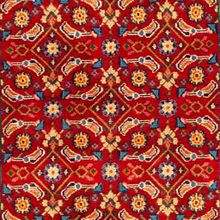Difference between revisions of "Moud Rug"
Jump to navigation
Jump to search
| Line 44: | Line 44: | ||
== Techniques and structures == | == Techniques and structures == | ||
=== Color and dyeing === | === Color and dyeing === | ||
| − | |||
=== Motifs and Designs === | === Motifs and Designs === | ||
| − | + | ||
=== Weaving techniques === | === Weaving techniques === | ||
| − | |||
== See also == | == See also == | ||
Revision as of 08:18, 4 March 2020
| Moud Rug | |
|---|---|
 Design of Mood Rug (Rugman) | |
| General information | |
| Name | Mood Rug |
| Original name | قالی مود |
| Alternative name(s) | Mood Carpet |
| Origin | |
| Category | Village |
| Technical information | |
| Common designs | Medallion, Herati (Fish) |
| Common colors | Navy Blue, Red, Blue, Brown |
| Dyeing method | Natural, Synthetic |
| Pile material | Wool, Silk |
| Foundation material | Cotton |
| Knot type | Asymmetrical (Persain), Jufti |
Mood rugs, reputed to be among the finest in the world, are hand woven in the city of Mashad in the Province of Khorassan. This great weaving center is also a trade center for the rugs produced in the neighboring towns and villages. You may notice that Mood rugs have some characteristics that are similar to a rug produced in Birjand. Although most are woven in workshops in the city, it is possible to find occasional Mood rugs that have been woven on a home loom. Skilled artisans use the asymmetrical Persian knot in the creation of this very special carpet as it offers more precision when weaving the intricately detailed patterns.
History
Materials
Foundation and Pile
Techniques and structures
Color and dyeing
Motifs and Designs
Weaving techniques
See also
References
Bibliography
- Abraham Levi Moheban, (2015), The Encyclopedia of Antique Carpets: Twenty-Five Centuries of Weaving, NewYork: Princeton Architectural Press.